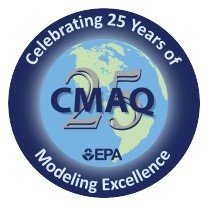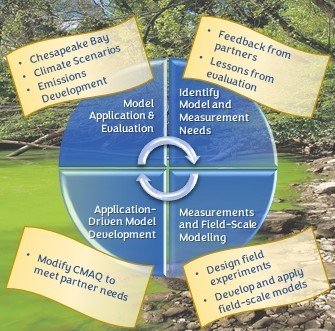CMAQ: Demonstrating Skill Across Media and Around the World
Published June 21, 2023

This month, EPA proudly celebrates the 25th anniversary of the initial release of EPA’s Community Multiscale Air Quality (CMAQ) modeling system, which occurred June 30, 1998. In Part 2 of this three-part series, we share how CMAQ has been working toward a “one environment–one health” approach throughout its lifetime.
Multimedia Modeling: Extending the One-Atmosphere Approach to One-Environment
The initial development of CMAQ in the 1990s was motivated by a “one-atmosphere” concept where atmospheric pollutants would be addressed holistically within the same model. Over time, CMAQ was extended to address pollutants using a “one-environment” approach that included components which followed the pollutant exchange in agriculture, watersheds, and hydrological processes. This approach linked CMAQ to various EPA modeling tools to address the movement of nitrogen through air, water, and soil.

Notably, “We have been able to better characterize the contribution of atmospheric nitrogen deposition to ‘dead zones’ in the Chesapeake Bay by connecting CMAQ with water quality and ecosystem models. We then characterized how emission reductions due to the Clean Air Act have reduced the atmospheric contribution to the development of these dead zones, improving ecosystem health,” reflected EPA research physical scientist Jesse Bash.
In addition to the Chesapeake Bay, CMAQ has also been used to explore nitrogen loading in Tampa Bay, throughout the Mississippi River Basin, and in the Albemarle-Pamlico Basin in coastal North Carolina. These studies illustrate how the exchange of pollutants through air, water, and soil can disrupt the services provided to people by nature.
Expanding the Scales: Moving from Statewide to Metropolitan and Global Scales
Increases in computing power and affordability of disk space after the turn of the millennium allowed CMAQ to expand from regional simulations that covered week-long pollution episodes to instead explore air quality with new lenses. For example, as emissions controls improved air quality in the U.S., the relative importance of pollutants from afar increased. In response, rather than limiting to only the U.S., CMAQ was set up to cover the Northern Hemisphere and simulate movements of pollutants across the oceans to better quantify the portion of pollutants that could respond to potential changes to air quality management in the U.S.
This new capability added an important new dimension, as noted by Rohit Mathur, senior EPA research physical scientist. “Expanding the applicability of CMAQ to hemispheric scales enabled scientifically rigorous examination of atmospheric processes across scales and provided a robust framework for examination of U.S. air quality issues in context of the changing global environment,” Mathur said.
In addition, greater computing power allowed CMAQ to focus on urban areas, exploring issues like non-attainment of national rules governing air pollutants of concern, and addressing environmental justice concerns. Moving to finer spatial scales emphasized the complex local interactions between weather and air quality, especially at the intersections of land and water in areas with concentrated and vulnerable populations. Jon Pleim, EPA research physical scientist, described the value of using CMAQ at finer scales. “With the capability to model air quality at very fine scales, we can predict air pollutant concentrations for the people on the streets of our cities,” Pleim explained. Both Mathur and Pleim contributed to the initial CMAQ development in the 1990s and remain with EPA today.
Connecting the Loop: Simulating the Impact of Air Chemistry on Weather
Those increases in computing power also fueled greater sophistication in the science behind CMAQ. Air quality models, like CMAQ, had typically used weather data only as input to describe the atmospheric conditions where pollutants interacted. However, chemical compounds also affect the earth-atmosphere radiation budget and formation of clouds, which can alter temperature, atmospheric mixing, and rainfall, and consequently modulate air quality. This so-called “two-way feedback” between weather and pollutants more accurately reflects the interplay that occurs in nature and is critical to characterizing air quality where people live.

“Weather models usually use climatology to describe the amount of aerosol which can absorb and/or scatter sunlight in the atmosphere. A generalized coupler with various computational considerations, such as accounting for different parallelism configurations in the models, was developed in-house to convey situation-specific aerosol information from CMAQ to the weather model to refine radiation budget calculations,” explained EPA research computer scientist, David Wong, who has maintained the efficiency in CMAQ’s algorithms since the early 2000s. This feedback loop between weather and chemistry bolsters the use of CMAQ to better understand air quality under changing conditions, and adds fidelity to use CMAQ to study interactions between climate change and air quality and their impacts on human health.
Understanding and Quantifying Emissions from Natural Sources
Some chemical compounds that affect air quality originate from the environment itself. These “natural sources” of emissions are created from wildfires, lightning, sea spray, wind-blown soil, and plants. These emissions combine with sunlight and manmade pollutants to alter the air we breathe. As contributions from manmade emissions have been reduced in the U.S., understanding variability in air quality due to natural emissions has become more important. For example, Daiwen Kang, EPA research physical scientist, emphasized that adding emissions from lightning to CMAQ “improved our understanding of lightning’s impact on ground-level ozone, especially over the regions where, despite many years’ effort to reduce manmade emissions, high ozone pollution events have still been frequently observed.” Emissions from natural sources are generally difficult to measure routinely, so their occurrence and variability are often estimated. Therefore, quantifying and characterizing natural emissions is an active area of research for CMAQ.
C = Community of Model Users: The International Effect
Although there was a regulatory need for CMAQ, the development team embraced the concept of “community” to remain current with the state-of-the-science and to broaden the model’s user base. Shortly after the initial release of CMAQ, EPA helped establish the Community Modeling and Analysis System (CMAS) Center, which was designed to cultivate a community of air quality modelers across researchers and practitioners. The CMAS Center—currently hosted at the University of North Carolina at Chapel Hill—has been an important conduit between EPA and the CMAQ user community for promoting, distributing, maintaining, and training for CMAQ. The CMAS Center hosts an annual three-day conference that draws considerable participation from users across the globe. Interactions at the annual conference have led to valuable collaborations and updates to the CMAQ system.
In addition, the prolific use of CMAQ beyond the United States launched a decade-long international model evaluation program with partners in Canada and across Europe. This model evaluation initiative involved comparable models to CMAQ, and recognized the value of partnering across geopolitical borders, scientific models, and regional-to-global scales to strengthen the science used for air quality management. Christian Hogrefe, EPA research physical scientist and co-lead of the initiative, explained, “Leveraging the collective power of a broader scientific community, experiences gained through [the coordinated evaluation activities] have contributed to using more robust modeling approaches when managing air quality over the U.S. in the presence of long-range transport of air pollution” across the Northern Hemisphere. This multi-phase international initiative improved the understanding of air quality science and increased the robustness of CMAQ and its air quality management cousins.
Exploring Emissions Reduction Scenarios – Extensions for the Air Quality Manager
Some of the more valuable aspects of CMAQ are in the additional tools that are tailored for air quality management. Those tools are “add-on” components that allow practitioners to assess the origins of harmful pollutants, track the movements of those pollutants in space and time, and optimize air quality management strategies.
EPA research physical scientist Sergey Napelenok explained, “Source apportionment and sensitivity assessment provide additional, complementary information on the relationship between sources of atmospheric pollution and its ultimate levels in the ambient air that lead to exposure to people, crops, and other important receptors. The tools allow users to efficiently screen for the relative importance of various emissions sectors and to answer how pollutant levels would respond to considered changes in emissions.”
Within the last couple of years, the CMAQ team has integrated these air quality management components into the primary release of CMAQ. This change to the public release structure for CMAQ keeps the diagnostic tools that facilitate air quality management fully accessible to practitioners in state and local governments.
Read more stories about CMAQ:
- CMAQ: Celebrating 25 Years of Air Quality Modeling Excellence
- CMAQ: Tackling Emerging Concerns and Building for the Future
Follow @EPAresearch on Twitter throughout 2023 as we highlight some of the accomplishments, milestones, and notable elements from CMAQ’s 25-year history, and search for #CMAQ25th.
This series was written by Tanya Spero, a research physical scientist in EPA’s Office of Research and Development. She joined the CMAQ Team just prior to the initial release of the model in 1998, and she remains active on the team today.
